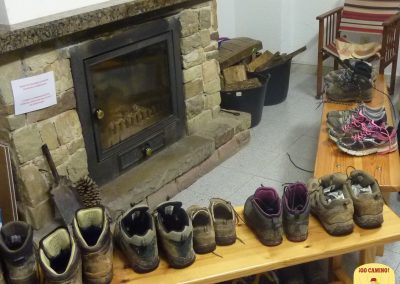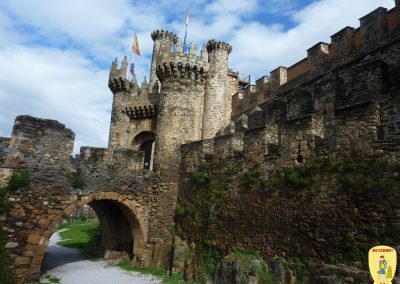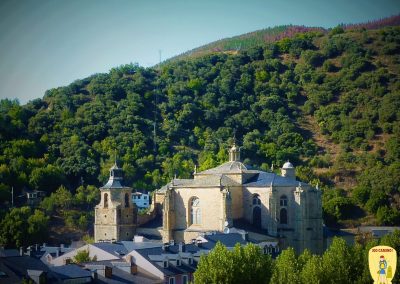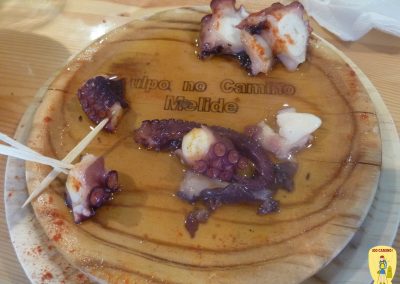
Camino Francés
We accompany you on your first steps on your way to Santiago de Compostela, in small groups of a maximum of ten persons. We follow the path of the pilgrims towards Santiago, respecting your own rhythm.
2021 and 2022 are Holy Years. The Holy Year is celebrated when the 25th of July, the feast of St. James the Apostle, falls on a Sunday. Just think that every century, this happens only 14 times. During the Holy Year, the Pilgrim’s Mass is celebrated more frequently, as well as the use of the famous Botafumeiro in such celebrations.
Many pilgrims still use this pilgrimage as a way to find some answers or simply take some time away from their overly busy lifestyle, or to balance their life.
Departures
- 18/06-01/07/25
Astorga
A visit of the Roman city of Astorga, with it’s sensational Gaudí building known as “Palacio Episcopal” greets us. Astorga, famous for its chocolate and mantecadas. We visit the Cathedral of Astorga where we will get our first stamp.
Day 1: Astorga – Rabanal (20,6 km) – ↗322m↘53m
Passing by Maragato villlages (where it is believed that the last Moorish people in Spain reside), we stay at the most authentic and welcoming village called Rabanal with it’s beautiful mountain scenery and fresh air. There is a Pilgrim’s mass and blessing with the monks in the evening at a 12th century Romanesque church for those who are interested or you can have an evening stroll through the village.
Day 2: Rabanal – El Acebo (16,5 km) – ↗491m↘479m
On day 2 we pass by the highest point of our journey : Cruz de Ferro (1,504 m). The cross has become the symbol of the pilgrim way of St. James. Take time to reconnect with the purpose of your journey before adding your stone of other token of love and blessing to the great pile that witnesses to our collective journeying. We stay overnight in a typical mountain village of El Acebo where we enjoy an infinity swimming pool overlooking the mountains. We have entered now the beautiful Bierzo region with its sheltered microclimate and vineyards.
Day 3: El Acebo – Cacabelos (15,6 km) – ↗129m↘747m
due to a dangerous road we take transportation from Ponferrada into Cacabelos
We cross the medieval bridge of Molinaseca and have the chance to visit the “Castillo de los Templarios” or Templar Castle in Ponferrada, we are able to explore its interior and revel in its romantic past. We stay overnight in Cacabelos, an important medieval pilgrim halt with it’s archaeological and wine museum.
Day 4: Cacabelos – Trabadelo (18,7 km) –
↗399m↘328m
Today we head for Villafranca del Bierzo or was sometimes referred to as ‘ little Santiago’. We spend the night at Trabadelo before we will start our most demanding climb on the Camino.
Day 5: Trabadelo – Linares (21,7 km) – ↗1044m↘400m
From here it is one of the steepest stages of the whole pilgrimage but the climb is rewarded with stunning views. From Las Herrerias you can even rent a horse to help with the climb up. We have now entered the Galicia region. The town of O’ Cebreiro is like out of a fairytale, all stone and thatch with Celtic music in the background welcoming you to to Galicia!
Day 6: Linares – Triacastela (18 km) – ↗313m↘869m
Mostly downhill, there are several villages and splendid views in every direction, early morning mist can give rise to the most astounding ‘floating islands’. We have an easy day and spend the night in Triacastela. Triacastela which used to be an important stop for medieval pilgrims coming down off the mountain with several hospices and extensive monastery.
Day 7: Triacastela – Sarria (21,3 km) – ↗571m↘789m
Today we will arrive in Sarria but have an option to visit one of the oldest and largest Benedictine monastery in Spain called ‘Samos’ (transportation not included). Sarria with its Celtic origins was a major medieval centre for for pilgrims with monasteries, chapels and churches.
Day 8: Sarria – Portomarin (22,1 km) – ↗494m↘579m
From Sarria into Portomarin is a lovely woodland paths and gravel tracks. It is on this part of the route where we will find the landmark indicating 100 Kms left to arrive at Santiago de Compostela. Portomarin is located on the side of the river Miño. Actually, this is the new Portomarin. The old one, is submerged under the waters of the Miño river in the Belares Dam since 1963. The old Portomarin was a very important part of the Camino during the Medieval Ages. It had a big bridge and a Hospital. Now, all of it is underwater. During the Autumn the old town resurfaces with the descent of the river flow. The great church constructed during the XII Century by the knights of the Order of St. John of Jerusalem, was dissassembled, stone by stone to be rebuilt in the place where it is located now.
Day 9: Portomarin – San Xulian (31 km) – ↗597m↘499m
This part of the way crosses the Ligonde Mountain range that separates the Miño and Ulla rivers. This was a medieval stop where Charlemagne once stayed. It has a nice start ascending Mt. San Antonio and walking through pine trees and meadows. After that, most of this way runs along paved roads. Along the way, we will find interesting churches to visit. We spend the night in San Xulian a house which is part of an old mill.
Day 10: San Xulian – Arzua (25,4 km) – ↗428m↘597m
From San Xulian into Arzua it crosses the border in between the province of Lugo and La Coruña. We pass by Melide or ‘Pulpera’ : famed for its squid where it links with the Camino Primitivo and continues through many beautiful scenaries such as the Catasol River. The last destination of the day is Arzua. Along the way we will be walking through some eucalyptus and oak trees forests and very traditional Galician hamlets where you will see many farm animals.
Day 11: Arzua – Pedrouzo (19,8 km) – ↗474m↘485m
One more time we will be walking among meadows, oaks and eucalyptus. Also, we will be passing through small and traditional hamlets. Most of this walk is along dirt roads. The walk is easy with some up-hills and many flat sections. This journey will be so much easier than the previous ones. It is probably a good way to get ready for the big moment of entering Santiago de Compostela the next day!
Day 12: Pedrouzo – Santiago de Compostela (19,8 km) – ↗378m↘422m
Today we will walk the last kilometers before we get to our final destination: the Plaza del Obradoiro in Santiago de Compostela. All the previous meadows, sheep’s, cows, shades, mud, conversation, self-knowledge, mysticism, religion, wine, Indo-European languages, blisters, stones, bandages, boots, up-hills, down-hills, sacrifices and efforts will disappear soon. Once we get to Santiago, the slabs of its ground will cool-down our suffering feet. Then we will be able to admire the Portico de la gloria, to hug of the saint, the saint door and the Botafumeiros in the Cathedral of Santiago. At the Monte do Gozo, we will have the first sight of the city of Santiago de Compostela.
From this point we will be walking through streets until we will arrive at the ‘plaza del Obradoiro’. Being ‘ fumigated’ by the botafumeiro in the Santiago Catheral, for many pilgrims, is the formal end of their journey. Seeing the swinging through the Church of the giant censer and touching the image of the Apostle Santiago. With our Compostela now in our possession, we finish off the evening with a last communal meal.
¡Buen Camino!
What is included in your trip?
pilgrim’s kit containing pilgrim passport, scallop shell, packing list
my experienced guidance – we have a daily briefing at dinner
transport of your luggage – limited to one transport bag during the walk
food: breakfast and snacks
on arrival in Santiago your Compostela
a unique and amazing experience you will never forget!
The groups consist of up to ten people. You can socialise as much or as little as desired – some people like to walk in groups, others prefer to hike alone. It’s your choice- it is your Camino!
Number of overnight stays: 13 nights (from Astorga)
Number of km to be hiked: 247.7 km
Price: 1.699 EUR
Fitness level: ![]()
![]()
one can participate without specific physical preparation, but we recommend eg jogging, as well as cycling /swimming, are appropriate forms of training.
Excluded in the price:
Flights and travel insurance are not included. Do not hesitate to refer to me for any travel-related information. I am happy to help.
The best way to travel to Astorga, Spain :
Madrid airport is served by many budget carriers, there is a direct bus from the airport by Alsa to Astorga (around 5 hours). If your prefer to travel by train, from Madrid Chamartin trainstation it tatkes 2H52 minutes to reach Astorga. Sarria is about a 5 to 6 hours trainride from Madrid, Chamartin. Look up your timetable here: Renfe
“To arrive in Santiago like a young person, begin the Camino like an old man.”
What are you waiting for?

Camino's & Digital Detox:
Follow Go-Camino
All text and images © Copyright Go Camino and Elvira Rog.
The Go Camino logo, "Go Camino", "Digital Detox Camino, "Friese Camino" , "Camino Vino", "Camino Original" and "Camino Spiritual" are trademarks and/or service marks and/or registered trademarks of Go Camino and Elvira Rog in the Benelux and/or Spain and/or other countries.




















